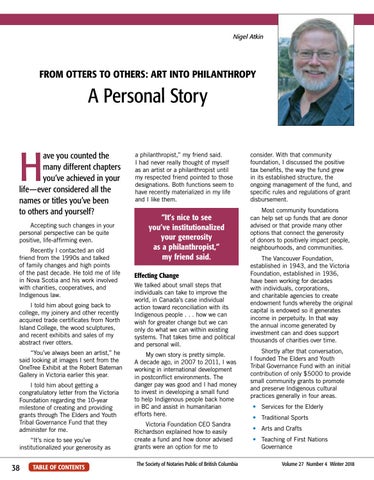Nigel Atkin
FROM OTTERS TO OTHERS: ART INTO PHILANTHROPY
A Personal Story
H
ave you counted the many different chapters you’ve achieved in your life—ever considered all the names or titles you’ve been to others and yourself? Accepting such changes in your personal perspective can be quite positive, life-affirming even. Recently I contacted an old friend from the 1990s and talked of family changes and high points of the past decade. He told me of life in Nova Scotia and his work involved with charities, cooperatives, and Indigenous law. I told him about going back to college, my joinery and other recently acquired trade certificates from North Island College, the wood sculptures, and recent exhibits and sales of my abstract river otters. “You’ve always been an artist,” he said looking at images I sent from the OneTree Exhibit at the Robert Bateman Gallery in Victoria earlier this year. I told him about getting a congratulatory letter from the Victoria Foundation regarding the 10-year milestone of creating and providing grants through The Elders and Youth Tribal Governance Fund that they administer for me. “It’s nice to see you’ve institutionalized your generosity as
38
TABLE OF CONTENTS
a philanthropist,” my friend said. I had never really thought of myself as an artist or a philanthropist until my respected friend pointed to those designations. Both functions seem to have recently materialized in my life and I like them.
“It’s nice to see you’ve institutionalized your generosity as a philanthropist,” my friend said. Effecting Change We talked about small steps that individuals can take to improve the world, in Canada’s case individual action toward reconciliation with its Indigenous people . . . how we can wish for greater change but we can only do what we can within existing systems. That takes time and political and personal will. My own story is pretty simple. A decade ago, in 2007 to 2011, I was working in international development in postconflict environments. The danger pay was good and I had money to invest in developing a small fund to help Indigenous people back home in BC and assist in humanitarian efforts here. Victoria Foundation CEO Sandra Richardson explained how to easily create a fund and how donor advised grants were an option for me to The Society of Notaries Public of British Columbia
consider. With that community foundation, I discussed the positive tax benefits, the way the fund grew in its established structure, the ongoing management of the fund, and specific rules and regulations of grant disbursement. Most community foundations can help set up funds that are donor advised or that provide many other options that connect the generosity of donors to positively impact people, neighbourhoods, and communities. The Vancouver Foundation, established in 1943, and the Victoria Foundation, established in 1936, have been working for decades with individuals, corporations, and charitable agencies to create endowment funds whereby the original capital is endowed so it generates income in perpetuity. In that way the annual income generated by investment can and does support thousands of charities over time. Shortly after that conversation, I founded The Elders and Youth Tribal Governance Fund with an initial contribution of only $5000 to provide small community grants to promote and preserve Indigenous cultural practices generally in four areas. • Services for the Elderly • Traditional Sports • Arts and Crafts • Teaching of First Nations Governance Volume 27 Number 4 Winter 2018


























